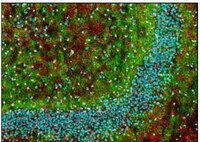NE1019 Sigma-AldrichAnti-Myelin Basic Protein Mouse mAb (SMI-99)
This Anti-Myelin Basic Protein Mouse mAb (SMI-99) is validated for use in ELISA, Immunoblotting, Immunocytochemistry, Frozen Sections, Paraffin Sections for the detection of Myelin Basic Protein.
More>> This Anti-Myelin Basic Protein Mouse mAb (SMI-99) is validated for use in ELISA, Immunoblotting, Immunocytochemistry, Frozen Sections, Paraffin Sections for the detection of Myelin Basic Protein. Less<<Recommended Products
Přehled
| Replacement Information |
|---|
Tabulka spec. kláve
| Species Reactivity | Host | Antibody Type |
|---|---|---|
| Gp, Ma | M | Monoclonal Antibody |
Products
| Katalogové číslo | Balení | ks/bal. | |
|---|---|---|---|
| NE1019-100UL | Plastová ampulka | 100 ul |
| References | |
|---|---|
| References | Evers, P. and Uylings, H.B. 1997. J. Neurosci. Methods 72, 197. Shin, R.W., et al. 1991. Lab. Invest. 64, 693. |
| Product Information | |
|---|---|
| Form | Liquid |
| Formulation | In PBS. |
| Positive control | Rat brain |
| Preservative | ≤0.1% sodium azide |
| Quality Level | MQ100 |
| Physicochemical Information |
|---|
| Dimensions |
|---|
| Materials Information |
|---|
| Toxicological Information |
|---|
| Safety Information according to GHS |
|---|
| Safety Information |
|---|
| Product Usage Statements |
|---|
| Packaging Information |
|---|
| Transport Information |
|---|
| Supplemental Information |
|---|
| Specifications |
|---|
| Global Trade Item Number | |
|---|---|
| Katalogové číslo | GTIN |
| NE1019-100UL | 04055977209884 |
Documentation
Anti-Myelin Basic Protein Mouse mAb (SMI-99) MSDS
| Title |
|---|
Anti-Myelin Basic Protein Mouse mAb (SMI-99) Certificates of Analysis
| Title | Lot Number |
|---|---|
| NE1019 |
References
| Přehled odkazů |
|---|
| Evers, P. and Uylings, H.B. 1997. J. Neurosci. Methods 72, 197. Shin, R.W., et al. 1991. Lab. Invest. 64, 693. |














